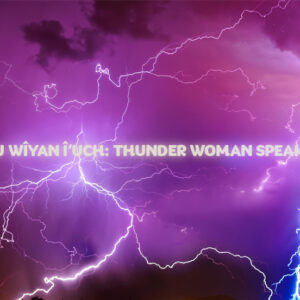
Long ago, the original voices were raised in harmony with this land. These voices sounded over the land in prayer, in ceremony, in thankfulness and in concert with all of Creation.
Today we listen to many different voices that purport to speak for the original people of Turtle Island. There are the voices of leadership talking about new relationships. There are the angry voices raised in protest over land and resource development. There are also numerous voices that speak to the compartmentalization and colonial thinking that infect our people like the foreign diseases brought to this island.
But the loudest voice is silence. The loudest voice is the hopelessness that plagues our communities. It is the voice of a young child, shuffled through foster homes. It is the voice of an abused mother. It is the voice of addiction. It is the voice of poverty.
This is the voice that the colonizers have gifted to our people. The marginalization and despair comes from a deep trauma that is both historical and ongoing. Trauma studies now point to genetic material holding memory. The memories and the suffering of our people remain in our bodies. It is the memory of shame, hardship, hunger, fear and misery. When the original people have been beaten to this extent, is it any wonder that they “can’t get over it” or that they believe suicide or slow death escaping through addiction is their only solution?
The deaths, that is the suicides of the young people in our communities is the hardest of this reality. When young people are asked what it are they want or what will help, they respond with two requests: their identity and their language. It is this knowing of oneself that will save future indigenous generations. It is the pride in keeping our languages. It is the pride in keeping our ways that are tied to the land and waters alive. It is the pride in knowing their indigenous existence matters that will give our young people purpose.
Each time deplorable indigenous circumstances peak, new suicides or community deaths, follow. Then there is a tidal wave of response by the oppressor government leader and the departments that “care about the Indians or aboriginal Canadians”. Usually solutions involve immediate attention from mainstream mental health or medical personal. How can a mental health person trained in Western science identify with the struggles of indigenous youth? Can they relate to the remoteness or semi-isolation these young people endure everyday? Can they relate to the trauma that these young people carry in the very fibres of their being? Can they relate to the poor housing conditions, the lack of clean water, recreation or educational services? It is laughable that the Prime Minister and the Federal Minister of Indian Affairs continue to talk about a new relationship without ever having understood the original people.
Then mainstream articles are written. Several editorials will suggest relocation to urban centres or where services are available. This just changes the location of the problem. The identity, language and cultural challenges still exist in or out of urban centres. The ongoing genocidal programs and policy still affect indigenous people regardless of location.
This is not an issue about access to services. This is an issue about negating a worldview and way of life to the point that indigenous children no longer know who they are. This is an issue about offering poorly assimilated services that are failing mainstream and therefore doubly ineffective in dealing with youth facing cultural upheaval.
This is the silence. This is the listening without hearing. This is the root of the genocide that continues to bring harm to the original stewards and protectors of this land.
There will also be media pieces about the cumulative harms that the indigenous experience. These articles will empathize with the ongoing struggle but offer little more than bleeding heart lamentations.
What is the solution? The solution was and remains with the original people. The solution is that this land was to be shared equally by all people. The indigenous had no concept of ownership because they did not seek to lord over Creation. The indigenous were thankful for the abundance of Turtle Island and happy to share with Creator’s other children.
This sharing was the basis for the original agreements between the first settler invaders and the keepers of the Eastern Door. Peace and friendship was to guide all future relations on this island. This is the original intent of why Canada – the STATE — exists today. Canada has inherited the state interest in the land but the original people remain the true caretakers of this island.
It is difficult to convey this understanding without using the oppressor terminology that lessens the depth of relationship between the indigenous and Creation. However, because the settler-invaders are without comparative concepts, sometimes terminology like ownership, title or landowners are used. For most of the indigenous, it is conceptually incorrect but has become the necessary language that must be used for indigenous voices to be heard.
The saving thought in this sad reality is this voice. The voice that mimics the rivers, the voice that speaks to the plant and wildlife is the voice that will remain. It will remain in the very pieces that have always made this land unique. This voice will remain as an echo and sound through the cosmos. It is this knowledge that the indigenous must remember so that their silence is heard.
“However, because the settler-invaders are without comparative concepts, sometimes terminology like ownership, title or landowners are used. For most of the indigenous, it is conceptually incorrect but has become the necessary language that must be used for indigenous voices to be heard.”


